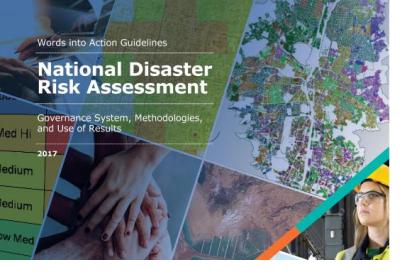The United Nations Office for Disaster Risk Reduction (UNISDR) has published guidelines on national disaster risk assessments to support the implementation of the Sendai Framework at the national level. National Disaster Risk Assessment (NDRA) is part of the organization's series of thematic guidelines "Words into Action", which aims to offer practical guides to implement the Sendai Framework.
The Sendai Framework is the most encompassing international framework to date on disaster risk reduction and sets four specific priorities for action:
- Understanding disaster risk
- Strengthening disaster risk governance to manage disaster risk
- Investing in disaster risk reduction for resilience
- Enhancing disaster preparedness for effective response, and to "Build Back Better" in recovery, rehabilitation and reconstruction
The report concentrates on the first of these priorities - understanding disaster risk - because it assumes that this understanding is the foundation for all disaster risk reduction actions and is tightly connected to the other three priorities for action.
The guidelines are intended to give an incentive to countries and support them in establishing their own national systems for understanding disaster risk that can be the key repository of all risk information that is available in public.
Geospatial information, including space-based information, plays an important role for understanding risk and implementing the NDRA, which is addressed in a dedicated chapter.
The report deals with the essential features of geospatial data by explaining the technology solutions for working with such data, the comprehensive standards systems that ensure interoperability and consistent quality of geospatial data and their metadata, the geospatial reference system (which is a key metadata element to be captured for all geospatial data sets) and the difference between scale and resolution in geospatial data.
The authors explain how geospatial analysis can be used in many risk assessment approaches by making some general remarks on the need of such data in case of natural hazards, explaining the synergy between multiple agencies and stakeholders that are typically involved in collating the data for a national risk assessment, and delivering two case studies.
Additionally, the section provides resources for further information.
The NDRA guidelines have been formulated through a collaboration among over 100 leading experts from national authorities, international organizations, non-governmental organizations, academia, think tanks and private-sector entities. Launched in 2015, the "Words into Action" initiative process aims to offer practical guides in implementing the Sendai Framework.
The United Nations Office for Outer Space Affairs (UNOOSA) and its programme on Space-Based Information for Disaster Management and Emergency Response (UN-SPIDER), together with many partners, established the voluntary, multistakeholder Global Partnership Using Space-Based Technology Applications for Disaster Risk Reduction (GP-STAR) in 2015 to facilitate the use of space-based technology applications for the implementation of the Sendai Framework. The network aims at providing advice and conceptual guidance to governments and organizations, promoting the use and expansion of thematic platforms of cooperation such as global technology pools and global systems to share know-how, innovation and research and ensuring access to technology and information on disaster risk reduction. Today it comprises 33 partners representing national, regional and international organizations.

